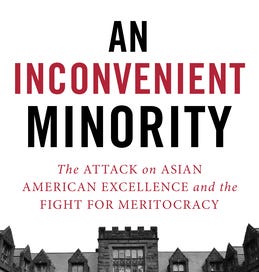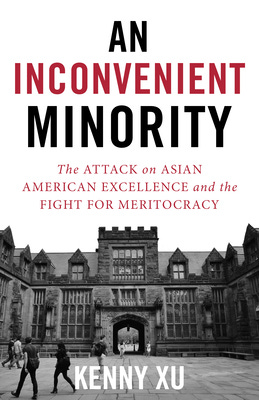An unfair burden to bear
Exposing the shameful discrimination against Asian American students by many of the country’s elite educational institutions.
An Inconvenient Minority: The Harvard Admissions Case and the Attack on Asian American Excellence
By Kenny Xu
“While we aren’t defined by our circumstances, we certainly are shaped by them.”
It’s against this backdrop that I read Kenny Xu’s An Inconvenient Minority: The Harvard Admissions Case and the Attack on Asian American Excellence, which is a detailed and interesting book on a topic that can be both complex and compelling: how the nation’s elite colleges and universities, and public schools, purposely discriminate against Asian Americans in admissions.
Though the book was written in 2021, two years before the landmark Students for Fair Admissions v. Harvard lawsuit, which abolished race-based affirmative action programs in college admissions processes, readers will get a deep-dive into how pervasive—and pernicious—the anti-Asian bias was (and is) in higher ed and beyond, including at some of the nation’s top public schools, too, at all levels of instruction.
Justifiable…discrimination?
Far from taking place only the Ivies, the blatant bias and discrimination still plays out in nefarious ways nationwide, from California to Virginia to New York. Elite public schools such as New York’s Brooklyn Technical High School, one of the top schools of its kind in the country, has become ground zero for the push by many Black and Latino parents and school administrators to unfairly limit the number of Asian American students, who comprise 18% of the public school population but make up 61% of the school’s students.
Progressive politicians and leaders argue that the low numbers of Blacks and Latinos at these elite public schools, which often require an entrance exam, means they are “functionally racist and segregated,” as one New York Times article put it, because they collectively account for only 15% at Brooklyn Tech.
However, while the left-leaning leaders point to Asian and East Asian students’ numbers as if they are a privileged group overtaking a school meant to serve impoverished Black and Latino kids, the numbers tell a far different story.
“Fully 63 percent of Brooklyn Tech’s students are classified as economically disadvantaged. Census data shows that Asians have the lowest median income in the city and that a majority speak a language other than English at home.” [1]
Making enemies and assigning failure
My favorite part of the book was where Xu discusses the experience of Black students at historically Black colleges and universities (HBCUs) versus elite institutions like Harvard. He writes that Black students, who often excel academically and socially at HBCUs due to their supportive environment, which fosters a strong sense of belonging and community, often struggle at the Ivies.
Many experience feelings of isolation and fail to find cultural fit, which often deleteriously impacts their social and academic success. Xu, in making this point, echoes the words of prominent conservative thinkers who’ve complained that mismatching, instead of helping Black and Latino kids, actually hurts them.
If the goal is for kids to not only attend but graduate college, it’s clear that instead of pushing for more Black and Latino students to attend elite institutions, they should support policies that neither prioritize nor discriminate against any racial or ethnic group. Besides, the data is clear that elite schools are not pulling Blacks and Latinos from the poorest communities.
More than 70% of the Black and Hispanic kids who attend Harvard come from the top 25% wealthiest Black and Hispanic households. [2] I wrote on this topic a year ago, after the Supreme Court’s decision was announced.
Instead of commiserating over the likelihood that fewer Black kids will be admitted to Ivy League schools in the future, I suggest placing a priority on the nation’s historically Black colleges and universities. They graduate 20% of Black students in the U.S., and those graduates, on average, earn higher salaries than Blacks from many other universities.
Who should read the book
Though I was somewhat aware of the unfairness Asian American students are subjected to in higher ed and, to a lesser degree, at public schools like Brooklyn Tech across the country, reading this book made me angry.
At the very least, Xu’s detailed, thoughtful analysis and compelling storytelling makes an airtight case for pushing back against seeing Asian Americans as model minorities undeserving of fair treatment in education and beyond.




